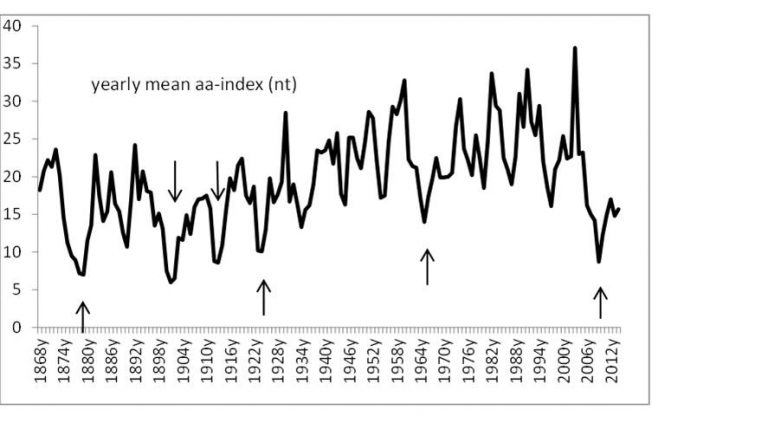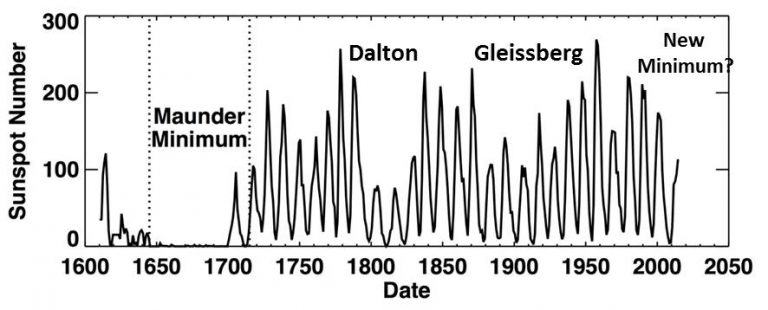By Kyoji Kimoto
I have found a 44-year cycle of heavy snowfall in Japan caused by a wavy jet stream, corresponding to Dalton and Gleissberg Minimum as follows [Kimoto, 2010].
1. 1833/heavy snowfall – Dalton Minimum (1795-1830)
2. 1877 heavy snowfall (44 years later)
3. 1918/heavy snowfall: Gleissberg Minimum (1898-1923) – 41 years later
4. 1963/heavy snowfall (45 years later)
5. 2006/heavy snowfall, Dalton or Gleissberg minimum (43 years later)
The heavy snowfall events have all occurred with sharp decline in the aa- index of geomagnetism as shown by four upward arrows in Fig.1. Two downward arrows show trough of geomagnetic activity in 1902 and 1912 associated with the events in which the planet Jupiter (JU), the center of mass of solar system (CM) and the Sun’s center (CS) are in line [Landsheidt, 1988].
Fig. 1: Yearly mean aa-index of geomagnetism.
Therefore, I estimate a probability of coming solar minimum as follows in Fig. 2.:
– Maunder minimum(1645-1715)(probability: 20%)
– Dalton minimum (1795-1830)(probability: 40%)
– Gleissberg minimum(1898-1923)(probability: 40%)
Fig. 2 :Sunspot data showing Maunder, Dalton and Gleissberg Minimum (NASA)
In 1988, Bucha showed decreased solar activity causes a wavy jet stream along with low aa-index of geomagnetism in line with my findings above. Thus, the solar minimum will cause extreme weather as well as global cooling which might begin in 2020 when the ocean inertia of 14 years is added to 2006 (phase change year of solar activity).
Jennifer Francis and Masato Mori claimed that recent harsh winter is caused by the Arctic sea ice loss with the AGW. Their narratives are rightly criticized here.
(References)
Bucha, V., 1988. Influence of solar activity on atmospheric circulation types. Annales Geophysicae 6, 513-524.
Kimoto, K., 2010. Is the AGW theory of the IPCC a mathematical error? (in Japanese), Rikotosyo, Tokyo.
Landscheidt, T., 1988. Solar rotation, impulses of the torque in the sun’s motion, and climatic variation. Climatic Change 12, 265-295.







For the cause of a wavy jet stream see here:
http://joannenova.com.au/2015/01/is-the-sun-driving-ozone-and-changing-the-climate/
There will be more wavy jet stream activity starting the second week of February as stratospheric warming wends its way through the atmosphere.
~~~~~~~~~~~~~~~~~~~~~~~~~~~~~~~~~~
Watch out for the warmisters crying about Arctic melting as the polar region winds stagnate with the incoming warmth. You’ve been warned!
~~~~~~~~~~~~~~~~~~~~~~~~~~~~~~~~~~
This warming episode has been caused by the recent increase in solar winds arriving from the solar coronal hole that was facing us.
See JMA, GFS and ECMWF weather models forecasts for more info or check out the weather model obsessive at gavsweathervids.com or his latest on https://www.youtube.com/embed/2vFPueI9WJk
That looks like nonsense. There are 4 other sharp troughs that show no reaction.
‘every 44 years’
In order for there to be 4 more sharp troughs you would have to add another 178 years.
According to the ocean temperatures it seems more that the cold is hiding in the oceans than any heath.
[…] Researcher: More Evidence Extreme Weather In Japan, Global Cooling, Linked To Solar Activity. By Kyoji Kimoto I have found a 44-year cycle of heavy snowfall in Japan caused by a wavy jet stream, corresponding to Dalton and Gleissberg Minimum as follows [Kimoto, 2010]. 1. 1833/heavy snowfall – Dalton Minimum (1795-1830) 2. 1877 heavy snowfall (44 years later) 3. 1918/heavy snowfall: Gleissberg Minimum (1898-1923) – 41 years later 4. 1963/heavy snowfall (45 years later) 5. 2006/heavy snowfall, Dalton or Gleissberg minimum (43 years later) The heavy snowfall events have all occurred with sharp decline in the aa- index of geomagnetism as shown by four upward arrows in Fig.1. […]